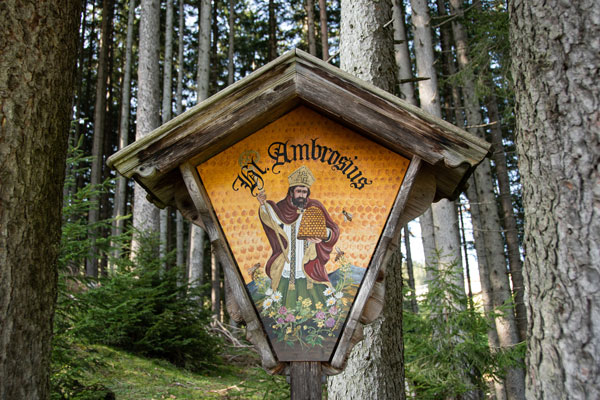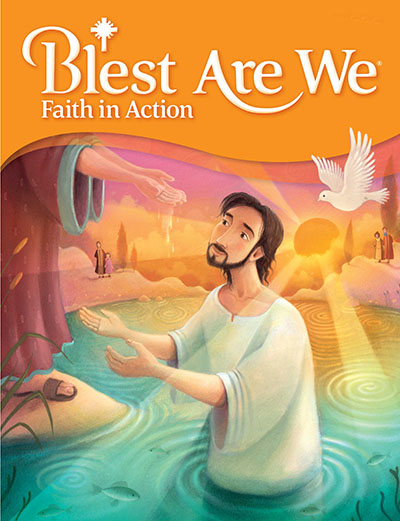One of our favorite summer dishes is ambrosia, a mixture of fruits, coconut flakes, mini marshmallows, cherries, and whipped topping. While the sugary additions diminish the healthy aspect, my sons will fight over the last bowl and have always agreed to the meaning of ambrosia as “nectar of the gods.”
I’ve recently discovered that ambrosia is also the term used for a mixture of pollen and nectar that worker bees feed to bee larvae and has an additional significance because Saint Ambrose is a patron of bees, beekeepers, and candlemakers.
When Saint Ambrose was a baby, so the legend goes, a swarm of bees landed on his face, leaving a drop of honey before moving on to their hive. Saint Ambrose’s father was convinced that the honey was a symbol that his son would be blessed with a honeyed tongue, and as it turns out, he certainly was.
Saint Ambrose was a prolific preacher, a doctor of the Church, and one of several saints who are connected with bees, beehives, and honey, all of which played a part in the early symbolism of the Church. Saint Ambrose saw the beehive, where there is a shared devotion, work and effort for the good of the colony, as a symbolic of the Church.
Certainly, bees, particularly honeybees, have a number of admirable characteristics that can serve as a model for us as Catholics and as educators. So, what is it about bees?
They are a symbol of strength and endurance – Given their aerodynamic deficiencies (chubbiness), honeybees are a marvel of flight. Bees have an incredible ability to carry more than 100 times their weight and can find their way back to the hive more than eight miles away carrying their weight in pollen. Any educator who has ever stood in a classroom understands the need for these characteristics for Catholic school teachers.
They act as communicators – Good communication is essential to the survival and productivity of the hive, just as it is in the world of educators. Bees communicate by releasing strong-smelling pheromones, carrying the scent of flowers back to the hive so other workers can find food sources, and though dancing. Fortunately, teachers don’t have to dance to communicate, though it could be the highlight of the year for students.
They are collaborators – Bees are hustlers, but they don’t hustle for themselves; they hustle for the hive. Catholic school teachers are also part of a larger body, working together for a common cause – to form disciples of Christ who are confident students, who are thinkers and doers, and who value the end result of learning.
The fruit of their efforts is sustenance – Bees create honey for the life of the bees in their hive, and fortunately for us, they make more than they can eat, so we benefit from their efforts. Honey is not only a food but has healing properties, as well. Similarly, Catholic school teachers feed the mind and spirit of their students, who ultimately go out into the world and, hopefully, work for its good.
This year, consider adding a bee or two to your classroom decorations. They may inspire a conversation about the power of bee characteristics and the role students have as stewards of the earth.
Also, If you use a candle for private prayer or meditation as I do, consider making it a beeswax candle for the beginning of a new school year and reflect on this little reminder from St. Augustine: “All of you who stand fast in the Lord are a holy seed, a new colony of bees.”
 About the Author
About the AuthorMary Regina Clifford Morrell, mother of six and grandmother to nine, is a Catholic journalist, author, and syndicated columnist who has served the dioceses of Metuchen and Trenton, New Jersey, and RENEW International in the areas of catechesis and communication.
Product Highlight
 Blest Are We Faith in Action - School Edition Grades K-8
Blest Are We Faith in Action - School Edition Grades K-8
The Blest Are We Faith in Action religious education program engages children, youth, and their families in learning what Catholics believe, how Catholics worship, how Catholics pray, and how Catholics live. Our technology-enhanced learning resources, including eGuides, eBooks, eAssessments, and online chapter reviews expand learning opportunities for students and flexibility for teachers.
Students will enjoy interactive connections with their textbooks, while teachers will find a variety of useful content for helping students on their formative journey of faith.
